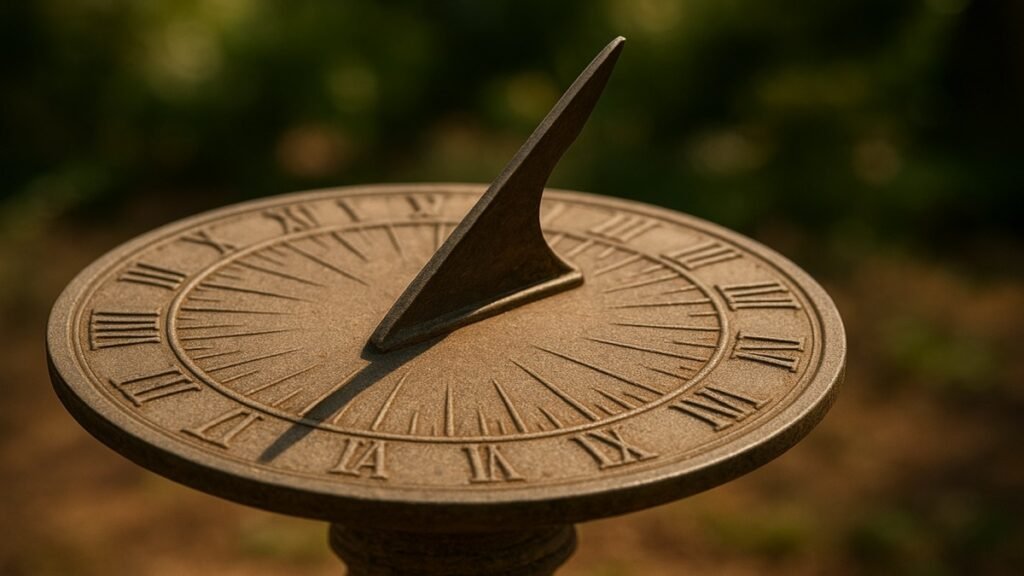Introduction
Before smartphones and wristwatches, before even pendulum clocks, humans had only one great timekeeper—the sun. Sun dials, often called nature’s original clocks, have guided people for thousands of years. They aren’t just tools for telling time; they’re symbols of human ingenuity, artistry, and our connection to nature.
What is a Sun Dial?
At its core, a sun dial is a device that uses shadows cast by the sun to indicate the time of day. The main parts are the gnomon, a raised piece that casts the shadow, and the dial plate, marked with hour lines.
The History of Sun Dials
Sun dials date back to around 1500 BCE in Egypt, where tall obelisks doubled as shadow clocks. Babylonians, Greeks, and Romans refined their designs, making them smaller and portable. During the Middle Ages, they adorned churches and gardens, guiding both daily routines and prayers. However, as mechanical clocks gained precision, sun dials slowly declined in practical use.
How Sun Dials Work
The principle is simple: as the earth rotates, the sun appears to move across the sky. The gnomon casts a shadow that shifts position throughout the day. Markings on the dial plate indicate hours. But here’s the catch—sun dials vary depending on latitude, and seasonal shifts change the shadow’s angle.
Types of Sun Dials
- Horizontal sun dials – Commonly seen in gardens, laid flat on the ground.
- Vertical sun dials – Mounted on walls, often seen on old buildings.
- Equatorial sun dials – The dial plate aligns with the Earth’s equator.
- Portable pocket sun dials – Carried by travelers before pocket watches existed.
Sun Dials Around the World
In Egypt, obelisks served as giant sun dials. China used advanced astronomical sun dials to track solstices. In Europe, beautifully carved garden dials were popular among nobles.
Symbolism of Sun Dials
Beyond telling time, sun dials carried deep meaning. Many bore inscriptions like “I count only the sunny hours”, reminding us of life’s fleeting nature. They symbolized mortality, wisdom, and the inevitability of passing time.
Sun Dials in Modern Times
Today, sun dials are mostly decorative—gracing gardens, parks, and courtyards. They’re also used as teaching tools, helping students visualize astronomy concepts. Recently, there’s been a revival in interest as people seek eco-friendly and meaningful alternatives to digital technology.
Advantages of Sun Dials
- Eco-friendly – No batteries or electricity needed.
- Connection to nature – They tie us directly to the sun’s rhythm.
- Aesthetic value – Beautiful stone, metal, and wooden designs enhance spaces.
Limitations of Sun Dials
Of course, sun dials have flaws. No sun? No time. Their accuracy is limited by seasons and latitude. And unlike modern clocks, they can’t track minutes with precision.
Famous Sun Dials Around the World
The Jantar Mantar in Jaipur, India, houses the world’s largest sun dial—accurate to within 2 seconds. Europe boasts countless historic dials carved into churches, while the U.S. features monumental sun dials in public parks.
DIY Sun Dial Projects
Creating a sun dial can be as simple as placing a stick upright and marking its shadow every hour. For garden lovers, decorative brass or stone dials add elegance. Kids can make paper plate sun dials to learn about the sun’s movement.
Sun Dials vs. Modern Clocks
Modern clocks win in accuracy, no doubt. But sun dials win in charm, symbolism, and their ability to ground us in the natural passage of time. They remind us that life isn’t just about minutes ticking—it’s about moments passing.
Future of Sun Dials
Architects and designers are reviving sun dials, blending ancient methods with modern aesthetics. They’re being used in eco-parks, schools, and monuments, keeping their cultural and educational value alive.
Conclusion
Sun dials are more than relics of the past—they’re living reminders of humanity’s deep connection with the cosmos. They may no longer rule our daily schedules, but they still inspire awe and teach us to appreciate the natural rhythm of time.
FAQs
1. Can a sun dial tell the exact time?
Not to the minute, but it gives a fairly accurate reading, especially around noon.
2. Do sun dials work everywhere?
Yes, but their design must match the local latitude to be accurate.
3. Why do some sun dials have mottos?
Mottos remind viewers about the value of time, often with philosophical or poetic meaning.
4. Are sun dials still being made today?
Absolutely! Many artisans craft them for gardens, parks, and educational purposes.
5. What is the largest sun dial in the world?
The world’s largest is in Jaipur, India, at the Jantar Mantar observatory.








